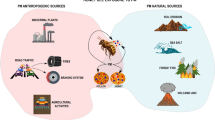Abstract
Inhalation pharmacokinetics of acetone in rats was studied using gas uptake techniques. Under conditions of negligible metabolism (saturation of metabolizing enzymes) the coefficient of distribution K eq between organism and gas phase was 220 which confirmed that acetone is mainly (but not exclusively) distributed within the body water compartment. The metabolic elimination of acetone from the animals followed strict Michaelis-Menten saturation kinetics; the K m corresponded to 160 ppm in the atmosphere, v max was 230 μmol · h−1 · kg−1. A shift in the distribution pattern of acetone under conditions of prevalent metabolism was theoretically predicted and experimentally proven; as the partial process of metabolic elimination was dose-dependent, this “depleted” the animal compartment from acetone in a dose-dependent fashion causing a shift in the “steady-state-constant”, K st .
Part of the acetone which was metabolically eliminated (4.7%) appeared in the urine as formate within 7 days after ending a 48-h exposure to acetone; this excretion was linear with time. The data suggested existence of a formate pool in the organism from which formate was released with delay. Hence, limitations may be inferred as to the applicability of urinary formate excretion as a quantitative indicator for changing conditions of acetone exposure.
Similar content being viewed by others
References
Andersen ME, Gargas ML, Jones RA, Jenkins LJ (1980) Determination of the kinetic constants for metabolism of inhaled toxicants in vivo using gas uptake measurements. Toxicol Appl Pharmacol 54: 100–116
Askew EW, Dohm GL, Huston RL (1975) Fatty acid and ketone body metabolism in the rat: response to diet and exercise. J Nutr 105: 1422–1432
Bässler KH, Horbach L, Wagner K (1972) Dynamics of ketone body metabolism in diabetic rats. Diabetologia 8: 211–214
Bates MW (1971) Kinetics of ketone body metabolism in fasted and diabetic rats. Am J Physiol 221: 984–991
Bates MW, Krebs HA, Williamson DH (1968) Turnover rates of ketone bodies in normal, starved and alloxan-diabetic rats. Biochem J 110: 655–661
Baumann K, Angerer J (1979) Untersuchungen zur Frage der beruflichen Lösungsmittelbelastung mit Aceton. Verh Dtsch Ges Arbeitsmedizin. Gentner, Stuttgart 20: 403–408
Briggs AP, Shaffer PA (1921) The excretion of acetone from the lungs. J Biol Chem 48: 413–428
Filser JG, Bolt HM (1979) Pharmacokinetics of halogenated ethylenes in rats. Arch Toxicol 42: 123–136
Filser JG, Bolt HM (1980) Characteristics of haloethylene-induced acetonemia in rats. Arch Toxicol 45: 109–116
Filser JG, Bolt HM (1981) Inhalation pharmacokinetics based on gas uptake studies. I. Improvement of pharmacokinetic models. Arch Toxicol 47: 272–292
Haggard HW, Greenberg LA, Turner JMC (1944) The physiological principles governing the action of acetone together with determination of toxicity. J Industr Hyg Toxicol 26: 133–151
Kaufman CF, Bergman EN (1971) Renal glucose, free fatty acid, and ketone body metabolism in the unanesthized sheep. Am J Physiol 221: 967–972
Klingmüller V, Erdmann-Müller GJ, Rausch-Stroomann JG, Brune G (1955) Schnellbestimmung wasserdampfflüchtiger Stoffe. Arzneimittelforsch 5: 105–109
Lindsay DB, Brown RE (1966). Acetone metabolism in sheep. Biochem J 100: 589–592
Mourkides GA, Hobbs DC, Koeppe RE (1959) The metabolism of acetone-2-14C by intact rats. J Biol Chem 234: 27–30
Price TD, Rittberg D (1950) The metabolism of acetone; gross aspects of catabolism and excretion. J Biol Chem 185: 449–459
Reichard GA, Haff AC, Skutches CL, Paul P, Holroyde CP, Owen OE (1979) Plasma acetone metabolism in the fasting human. J Clin Invest 63: 619–626
Rietbrock N, Hinrichs WD (1964) Eine einfache Methode zum quantitativen Nachweis der Ameisensäure in Harn und Blut des Menschen. Klin Wochenschr 42: 981–985
Sakami W (1950) Formation of formate and labile methyl groups from acetone in the intact rat. J Biol Chem 187: 369–378
Sulway MJ, Malins JM (1970) Acetone in diabetic ketoacidosis. Lancet 2: 736–740
Widmark EMP (1920) Studies on acetone concentration in blood, urine and alveolar air. Biochem J 14: 364–394
Young JD, Braun WH, Gehring PJ (1978) Dose-dependent fate of 1,4-dioxane in rats. J Toxicol Environ Health 4: 709–726
Author information
Authors and Affiliations
Rights and permissions
About this article
Cite this article
Hallier, E., Filser, J.G. & Bolt, H.M. Inhalation pharmacokinetics based on gas uptake studies. Arch Toxicol 47, 293–304 (1981). https://doi.org/10.1007/BF00332395
Received:
Issue Date:
DOI: https://doi.org/10.1007/BF00332395




